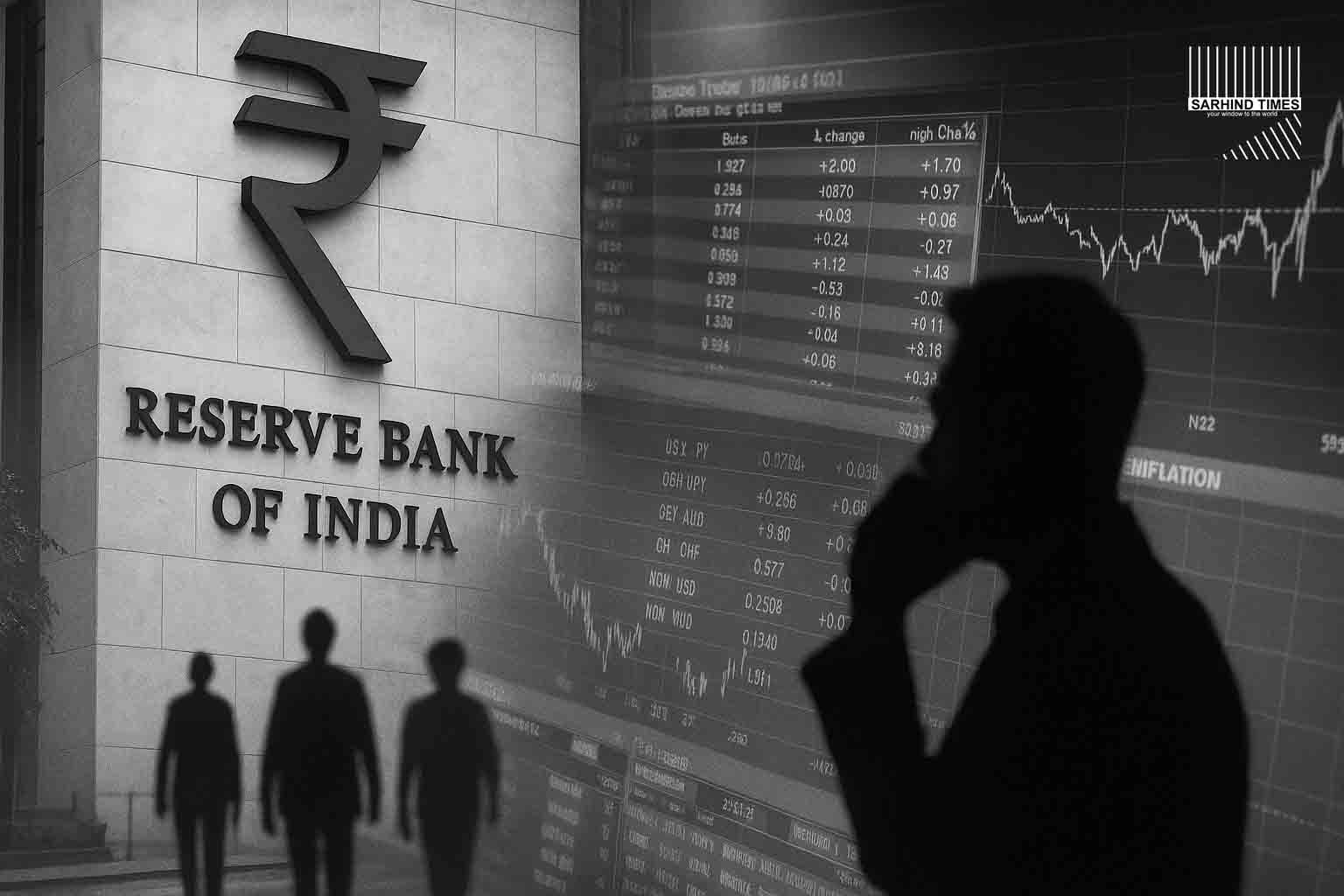With food prices easing, economists forecast headline CPI may fall below the RBI’s lower tolerance threshold — even as the rupee holds near ₹88.8 per dollar on steady central-bank intervention.
By SarhindTimes Business Bureau
Mumbai / New Delhi, October 2025
Disinflation Deepens as India’s CPI Nears Sub-2% Zone
India’s disinflation story appears to be entering its most pronounced phase in over three years.
A Reuters poll of 40 economists projects September’s Consumer Price Index (CPI) inflation at roughly 1.7% year-on-year, well below the Reserve Bank of India’s 2–6% target band.
If confirmed in the official release next week, this would mark the first time since 2019 that inflation undershoots the RBI’s comfort range — reflecting a mix of falling food prices, base-effect arithmetic, and cautious domestic demand.
“Headline inflation has decelerated faster than expected, led by vegetables and pulses,”
said Dr. Soumya Kanti Ghosh, Chief Economist at SBI.
“The moderation is broad-based, though core inflation is sticky around 3%.”
The development comes just weeks after the RBI kept policy rates unchanged at 6.50%, maintaining a neutral stance but signaling confidence that the disinflation trend is sustainable.
Why Prices Are Cooling
Economists cite several overlapping factors behind the slide:
- Food Disinflation: A correction in vegetable and cereal prices after record monsoon output.
- Energy Moderation: Stable crude oil prices near $84 a barrel despite global tensions.
- Global Goods Cycle: Lower input costs for manufacturing as global freight and commodity prices normalize.
- RBI Policy Lag: The cumulative 250-basis-point tightening between 2022 and 2023 continues to restrain demand-side impulses.
In August, CPI had already slowed to 2.3%, down from 3.1% in July.
Now, with September’s estimate dipping below 2%, analysts say India’s real policy rate (repo minus inflation) could turn sharply positive — a rare occurrence for emerging markets.
“India is now in a classic disinflationary sweet spot,”
said Madan Sabnavis, Chief Economist, Bank of Baroda.
“Growth remains decent, inflation is low, and the external balance is stable. It’s an ideal setup, but managing the next phase will be tricky.”
RBI’s Dilemma: When Good News Gets Complicated
While falling inflation eases pressure on households and borrowers, it presents a policy conundrum for the RBI.
A sustained drop below the 2% floor may invite calls for rate cuts, but the central bank has signaled caution.
Governor Shaktikanta Das has repeatedly stressed the need for “durable moderation” before shifting gears, warning that transient food disinflation can reverse quickly due to climate shocks or supply bottlenecks.
“We do not want to declare victory prematurely,”
Das said at the latest Monetary Policy press conference.
“Price stability must be consistent, not episodic.”
Market participants, however, are already debating the timeline for easing.
Futures pricing on the NSE shows the first 25-basis-point cut being priced in for February 2026, contingent on inflation staying below 3% and growth near 6.5%.
Currency Corner: RBI’s Quiet Defense of the Rupee
Even as inflation softens, the rupee has shown uncharacteristic stability, trading in a narrow band around ₹88.80 per U.S. dollar for nearly six weeks.
Traders attribute this calm less to fundamentals and more to the RBI’s discreet but decisive intervention through spot and forward dollar sales.
“The rupee’s range looks engineered,”
said a Mumbai-based currency dealer at a private bank.
“Every time it drifts past 88.9, the central bank sells dollars aggressively; below 88.6, it buys to rebuild reserves. It’s a soft peg without saying so.”
Officially, the RBI denies managing levels, insisting its actions are meant only to smooth volatility.
Still, data from the central bank’s weekly bulletin shows foreign-exchange reserves dipping by $4.1 billion in late September — likely due to spot market operations.
Importers and Exporters Adjust to New Normal
Import-heavy sectors such as oil marketing companies and electronics manufacturers say the rupee’s range-bound behavior has allowed better planning of hedges and inventory costs.
“We’re buying dollars ahead of festive-season shipments but at least the rate isn’t swinging wildly,”
said Rajiv Kaul, CFO of a consumer-durables firm.
“The RBI’s presence gives confidence.”
Exporters, on the other hand, worry that a strong rupee could squeeze margins if global demand softens.
With inflation falling faster than other emerging economies, India’s real effective exchange rate (REER) has appreciated about 3.5% in the past quarter, eroding competitiveness for textiles, pharma, and IT services.
Bond Market Reaction: Yields Ease
Government bond yields have edged lower in anticipation of softer inflation data.
The 10-year benchmark yield dropped to 6.78%, its lowest since April, as traders bet on policy continuity and steady demand from banks and insurance companies.
“If September CPI comes in below 2%, markets will price in a deeper easing bias,”
said Rahul Bajoria, MD & Head of EM Asia Economics, Barclays.
“However, the RBI may prefer to wait until Q4 before signaling any shift.”
For Borrowers and Savers: The Ripple Effect
For households, the macro numbers translate into mixed signals.
- Borrowers could see term-loan and mortgage rates soften marginally over the next quarter as banks adjust funding costs.
- Savers, however, stand to gain in the short term as real deposit returns rise — provided banks don’t immediately slash deposit rates.
“A low-inflation environment strengthens purchasing power and improves real returns,”
said Nirmala Menon, economist at a Mumbai mutual fund.
“It’s good news for retirees and fixed-income investors.”
Core vs. Headline: The Divergence
While headline CPI has cooled sharply, core inflation — which excludes food and fuel — remains sticky near 3.1%.
This suggests that service prices and housing rents continue to inch up even as grocery and vegetable costs ease.
The divergence poses a challenge for the RBI’s communication: celebrating low inflation without appearing complacent about underlying pressures.
“If food inflation rebounds, the base effect will vanish,”
warned Aurodeep Nandi, Nomura economist.
“Policy patience will be tested.”
External Sector: Trade and Oil Dynamics
India’s trade data for September showed exports up 6.2% year-on-year, aided by global demand recovery in engineering goods and pharmaceuticals.
Imports rose 5.7%, keeping the trade deficit steady at $23.4 billion — manageable given robust capital inflows.
Meanwhile, crude oil prices hovering near $84 a barrel have provided relief, with the fuel import bill down 8% year-to-date.
“A stable rupee and falling inflation cushion the current account,”
said Indranil Pan, Chief Economist at Yes Bank.
“We expect FY26 CAD at 1.2% of GDP — very comfortable.”
Stock Market Mood: Earnings Season Begins
Equity investors are now watching how disinflation feeds into corporate margins as the October-December earnings cycle begins.
Lower input costs, stable currency, and festive demand could yield a “Goldilocks quarter” for consumer-facing sectors like FMCG, auto, and retail.
The Nifty 50 closed the week up 0.4% at 25,180, extending its year-to-date gain to 9%.
Foreign portfolio investors have remained net buyers, adding ₹6,200 crore in October so far.
“The macro mix looks favorable — low inflation, stable rupee, and healthy consumption,”
said Ridham Desai, Managing Director at Morgan Stanley India.
“The risk is exuberance — asset froth can form quickly when liquidity feels infinite.”
Global Context: Diverging Policy Paths
India’s disinflation contrasts with the U.S. Federal Reserve’s hawkish persistence, as core U.S. inflation hovers above 3.4%.
European central banks, meanwhile, are cautiously eyeing recessionary risks.
“India stands out as a policy outlier — low inflation without growth pain,”
noted Mark Williams, Asia economist at Capital Economics (London).
“It strengthens the rupee’s credibility as a regional anchor.”
The Asian currency basket has weakened 2–3% against the dollar this quarter, but the INR remains flat, underscoring the RBI’s stabilizing role.
Policy Outlook: What Comes Next
Economists expect the RBI to maintain the repo rate at 6.50% for the next two meetings while fine-tuning liquidity through variable-rate reverse repos.
If inflation stays below 3% and growth remains steady above 6%, the first rate cut could come by Q2 FY26.
However, the RBI’s real challenge lies in balancing stability with flexibility.
Too much defense of the rupee can attract speculative inflows; too little can trigger volatility.
Likewise, cutting rates too soon could reignite asset inflation.
“It’s a delicate dance — between calm and complacency,”
said Dr. Sajjid Chinoy, J.P. Morgan’s Chief India Economist.
“The RBI has to manage optics as much as outcomes.”
Editorial Analysis: A Quiet Triumph, Carefully Guarded
India’s economy finds itself in a rare moment of macro serenity:
low inflation, steady currency, strong reserves, and consistent growth.
But beneath the calm lies the test of stewardship.
The coming months will determine whether this stability becomes a platform for long-term investment or a pause before turbulence.
In a world of volatility, India’s equilibrium may be its greatest comparative advantage — provided policymakers resist the temptation to over-engineer it.
Conclusion: The Calm Between Waves
For now, India’s economic weather looks tranquil.
Inflation is subsiding, the rupee is anchored, and monetary policy enjoys breathing space.
Yet, as every economist knows, macro calm can be fleeting.
Global oil shocks, climate volatility, or capital-flow reversals can rewrite the script overnight.
Until then, the RBI’s balancing act continues — one eye on inflation, the other on the exchange rate — steering between stability and stimulus in a sea that rarely stays still.
#Inflation #RBI #Rupee #Macro #IndiaEconomy #CPI #Finance #Markets #Policy #SarhindTimes






















+ There are no comments
Add yours